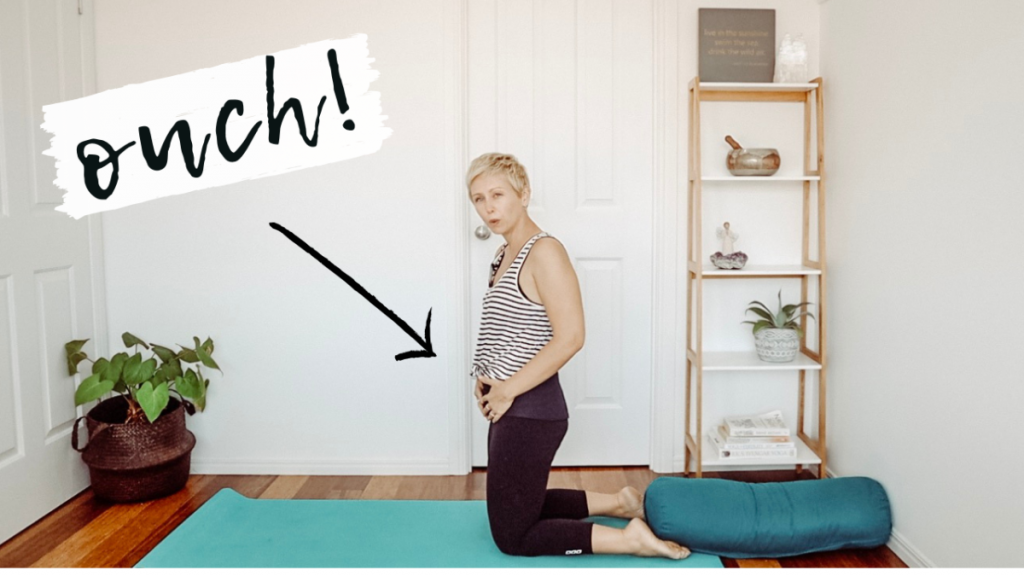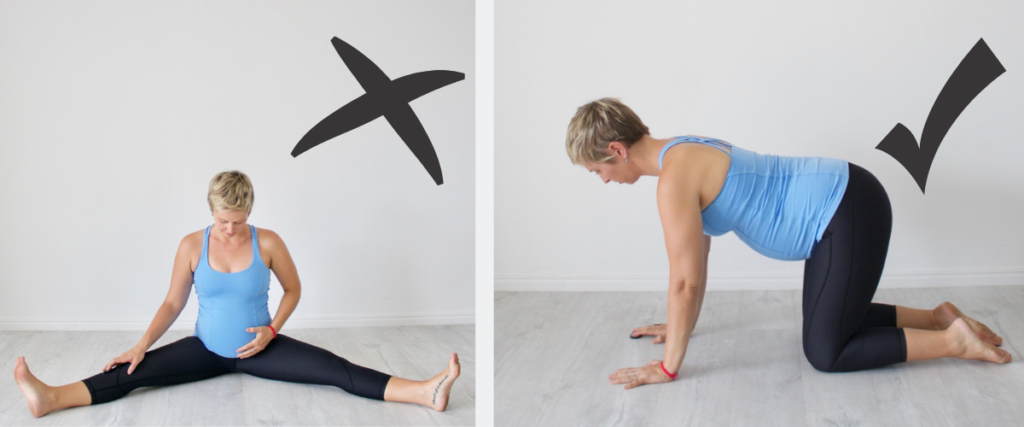Why you have painful SPD in pregnancy & how to fix it

During pregnancy some women will experience pain in the pelvis that makes everyday activities, even walking, unbearable. Pelvic Girdle Pain (PGP) and Symphysis Pubis Disfunction (SPD) in pregnancy is unfortunately common and can be excruciatingly painful for some women.
If you’re currently experiencing SPD in pregnancy, I want you to know that you don’t have to suffer through this for the entire 40 weeks. There are ways to manage flare ups of pelvic pain and to improve the stability of your pelvis to reduce your chances of experiencing future pain.
**This post contains affiliate links. That means when you click a link to purchase something I recommend, I receive a very small commission at no extra cost to you. Thank you for supporting my work. **
What is SPD in pregnancy?
SPD and PGP are caused by instability in the joints of your pelvis. It’s often felt as a dull ache or shooting pain in the vagina, the front of the pelvis, across the belly or down the inside of the thighs.
SPD in pregnancy is often caused by the release of relaxin in the body. Relaxin is the hormone that allows the ligaments and tendons that hold your pelvic bones together to relax. This is important to allow a widening of your pelvis for your baby to grow, and to move through during birth. Unfortunately, it can also allow these joins to relax too much, which creates instability and pain.
What does SPD in pregnancy feel like?
- Pain in the pubic bone, groin, perineum, hips, inside of the thighs, across the belly, in one or both buttocks.
- Pain that feels worse when you roll over in bed, walk up stairs, sit for long periods of time, stand on one leg or move your knees wide (like when you get out of the car).
- You might feel like you’re waddling when you walk to avoid the pain.
- You may (or may not) hear a clicking or grinding noise when you move your hips.
What can you do to reduce PGP or SPD in pregnancy?
Talk to an expert
While consulting the internet can be a good information gathering exercise, it’s important not to diagnose yourself. If you suspect you have SPD in pregnancy, go and see a physiotherapist who can assess your body and give you specific exercise recommendations for your condition.
Wear a support belt.
A support belt will feel like the least attractive thing you’ve ever worn, but trust me when I say it is entirely worth it to avoid pelvic pain during flare ups. During my pregnancy I wore one especially when I was working around the house and more likely to aggravate it through lifting and twisting.
Strengthen your pelvic floor muscles.
One of the main jobs of your pelvic floor muscles is to provide stability to your pelvis. Focused training on engaging and strengthening these muscles will help to create stability in your pelvis and reduce the likelihood of SPD in pregnancy. Use this yoga class to help you bring awareness to and strengthen your pelvic floor muscles.
Avoid wide leg stances.
Taking your knees wider than your hips moves the pelvic bones, and can aggravate pain if you’re suffering from SPD. Avoid pain by keeping your knees together or at a shallow stance where possible. For example, try to roll over in bed with your legs together and avoid any exercises that require a wide leg stance.

Try to keep the pelvis in a neutral position.
Where possible support your pelvis to stay in a neutral position when you’re sleeping. Lie on your side and place a pillow between your knees, ankles and under your belly A small pillow behind the back when you’re sitting in the car or on the couch can also help to keep the pelvis in a neutral position and reduce your pain.
Avoid wearing heels.
Seriously, just no. I really hope that if you’re suffering from SPD in pregnancy you’re not still putting yourself through the torture that is high heels, but just in case you are, it’s time to put them away.
Avoid crossing your legs.
Crossing your legs moves the pelvic bones asymmetrically and increases misalignment in your hips. You’ll probably also find this really painful to do when you have SPD in pregnancy. Try to keep your pelvis in a neutral position (think straight and square to your shoulders) to reduce your pain.
Avoid straining.
Avoid heavy lifting or activities that you have to strain to do (especially during a flare up). This might be hard to avoid if you’ve got other children who still ask to be carried, but where possible try not to lift anything where you feel yourself bracing to lift.
Strengthen the muscles that support the pelvis.
One of the best ways to reduce SPD in pregnancy is to focus on strengthening the muscles that support the pelvis. This helps to stabilise your pelvis and reduce the pain you’ll experience. Training the glutes, inner thigh muscles and gentle core work can all help to reduce SPD in pregnancy. Watch this video to learn what yoga poses you can do to strengthen these muscles.
Avoid sitting or standing for long periods of time.
After a long day of either sitting or standing you’ll probably find the ache in your pelvis is even worse. Try to break up long periods of either with gentle movements or going for a short walk. If you have to sit for long periods of time at work, ask if you can use an exercise ball to encourage movement and avoid pain.
When will SPD heal completely?
Many women find that after birth the pain of SPD decreases or stops entirely. Some women will need to continue strengthening the muscles around the pelvis to completely heal SPD. In this case working with a physiotherapist is best to ensure you are doing the right exercises for you.
Unfortunately, many women who experience SPD in pregnancy, will also suffer from it during in future pregnancies as well.
However, if you’re aware of your pelvic instability and continue working with the right exercises to support the pelvis during pregnancy you can avoid the painful flare ups. I had extremely painful pelvic instability during my pregnancy with my second boy, but I knew better during my pregnancy with Luca and for the most part avoided pain altogether.
If you’re experiencing SPD check out the two videos below. The first explains more about what SPD is and what do avoid when you’ve got it. The second are some yoga exercises to help reduce pain and strengthen the muscles that support the pelvis.
Want to learn more about practicing yoga safely throughout the three trimesters? Download my free guide here.
Want more yoga for pregnancy and birth? Start your free 30 day trial of my Online Yoga Circle membership here.

[…] These particular poses will help to create space but also stability in your pelvis. (You want your pelvis open to allow baby to move through freely during birth, but also stable so that you don’t have painful conditions like SI or SPD) […]